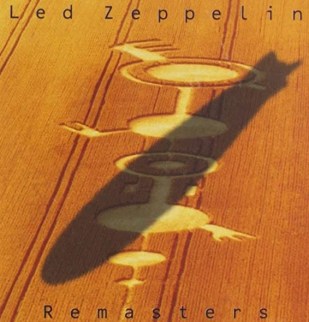by Tim Gilmore, 10/4/2022
To us, on the inside, the landscape communicates through signs and architectural styles and gardens and garbage and trees and streams and doors and tens of thousands of interhuman behaviors explicit and implied.
We miss most of it.
To the birds we send signals unwittingly, disrupting flight and migration patterns and millennial breeding trajectories and misinforming them of food sources and the possibilities of home.
The largest signs we transmit outward to abstraction – and to aircraft pilots – and satellite systems – to the stars.
Suburban tract housing, seen from the sky, says we are orderly, regimented, uniform, lacking in individuality, lined up in our hives and colonies like bees or ants.
With the 1970s came the crop circles. Led Zeppelin used an image of the shadow of a zeppelin over crop circles on its 1990 Remasters album cover. On September 10, 1991, The New York Times reported that two “jovial con men in their 60s,” David Chorley and Doug Bower, had created the series of strange configurations in wheat fields across the English countryside that baffled people around the world.
Said the Times: “Scientists from Britain and Japan have monitored the sites with scientific equipment, suspecting the circles might be a result of unusual and very sudden whirlwinds, and small armies of mystics, flying saucer fanatics and believers in the occult have paid them pilgrimages, trying to sense their hidden energy fields.”
What, then, does the interchange spiral at Interstate 295 and J. Turner Butler Boulevard say and to whom? Is it, as has been claimed, “elegant,” or does that imply artistic vision? If the interchange, as seen from above, is “beautiful,” because of its symmetry and graceful contours, can it be called art? It’s a feat of engineering, but it’s not Robert Smithson’s 1970 land art masterpiece, Spiral Jetty, nor the ceremonial Grand Shell Ring which the Mocaman Indians built nearby 1,000 years ago.
In what lies the difference between beautiful engineering and architecture? Surely birdsong, while beautiful, can’t be called art, without a certain kind of intentionality? Or do these questions belie a human blindness toward all intentionalities outside the narrow scope of our awareness? Aren’t trees intentional in their communication through massive scales of intertwined root systems and fungal networks, as scientists and writers like Suzanne Simard and Peter Wohlleben have shown us? Can we even really discuss intentionality and art without yet being able to define consciousness and intelligence?
Whatever the Jacksonville Interchange Spiral might say to the clouds about human intelligence, or design, or meaning, it certainly exemplifies the blindness of our driving ourselves in circles unaware of the larger shape we track.
This clockwise spiral, a turbine or whirlpool interchange, takes shape from right hand exits and left turning ramps. It costs less but eats up more land than diamond interchanges, trumpets and cloverleafs.
Where we stop, nobody knows. We get places, but never do. A connector of place, never stopping, the interchange is the opposite of place. It’s speed outside of time. In the spiral, you never die. In the spiral, you’re not really alive, but you live forever.








